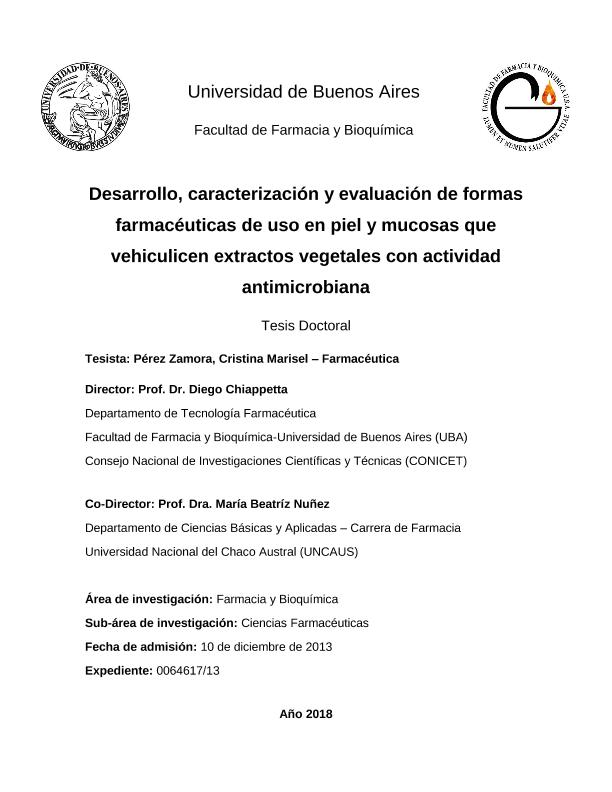Tesis doctoral
El uso de plantas para curar enfermedades y cicatrizar heridas es una costumbre que data de miles de años y una herencia de las antiguas civilizaciones. A pesar de que una importante proporción de la biodiversidad vegetal del planeta se encuentra en el continente americano, son muy pocos los productos farmacéuticos desarrollados a partir de ella. Esta tesis tuvo como objetivo desarrollar y caracterizar formulaciones de aplicación tópica (geles, emulgeles y películas), para su uso en piel y mucosas, que vehiculicen una combinación de extractos vegetales con actividad antibacteriana y antiinflamatoria. Los extractos hidroalcohólicos de Lippia turbinata Griseb. y Lippia alba (Mill.) N. E. Brown se obtuvieron mediante lixiviación; se hizo la caracterización físico-química, se cuantificó el contenido de fenoles totales, se evaluó la actividad antibacteriana y antiinflamatoria de los extractos solos y su combinación. Los excipientes empleados para las formulaciones en gel y emulgel fueron: Carbopol® 934 y 940, PemulenTM TR1 y TR2, Politrap®, Sepigel® 305, carboximetilcelulosa sódica, metilcelulosa, hidroxietilcelulosa, Ceral PW, Ceral 10, alcohol estearílico, alcohol cetílico, alcohol cetoestearílico, ácido oleico, glicerina, propilenglicol. Al producto terminado se le realizó una caracterización de las propiedades físicas: características organolépticas, extensibilidad, viscosidad, pH, conductividad, perfil de textura, permeación y análisis microbiológico. En el caso de las películas se empleó hidroxipropilmetilcelulosa (HPMC), distintos tipos de Eudragit®, propilenglicol, glicerina, sorbitol y sacarina. Se realizó la caracterización mediante evaluación del aspecto, contenido de polifenoles, estudio de liberación, índice de humectación, resistencia a la rotura, espesor, mucoadhesividad y permeación. Luego fueron sometidos a estudios de estabilidad en distintas condiciones de temperatura y humedad. Los emulgeles probados no fueron estables, presentaron separación de fases, por lo que no fueron seleccionados para continuar su estudio. De los geles formulados, el gel con Sepigel® al 4% (p/p) presentó mejor aspecto, olor característico de las especies vegetales, de color marrón, sin presencia de grumos y con buena extensibilidad. Los geles tuvieron una permeación in vitro de la piel porcina de hasta un 30% y baja retención en el epitelio de ensayo (<15%). Además, no presentaron contaminación microbiana y fueron estables durante 18 meses. Con respecto a las formulaciones tipo película, el excipiente HPMC al 1% (p/p) fue el más adecuado para el fin propuesto. La película resultante presentó una superficie de apariencia lisa, brillosa, de color marrón, inodora, dulce y con sabor característico de los extractos vegetales. También conservó la actividad antibacteriana de los extractos, siendo estable en ambiente fresco (entre 8 y 25 ºC) y seco (<58% humedad relativa). Las películas mostraron baja permeabilidad in vitro en mucosa oral porcina (≤13%), con mayor porcentaje de retención en el epitelio (≤43%). Las películas no presentaron contaminación microbiológica durante 24 meses. Estos resultados demuestran la factibilidad de vehiculizar el extracto en una formulación de tipo gel y en películas, logrando conservar el efecto antibacteriano del extracto y manteniendo la estabilidad en el tiempo sin el uso de conservantes antimicrobianos. The use of plants to cure diseases and heal wounds is a custom that dates back thousands of years and a legacy of ancient civilizations. Although a significant proportion of the planet's plant biodiversity is found on the American continent, very few pharmaceutical products developed from it. This thesis aimed to develop and characterize topical application formulations (gels, emulgels and films), for use on skin and mucosa, and to transport a combination of plant extracts with antibacterial and anti-inflammatory activity. Hydroalcoholic extracts of Lippia turbinata Griseb. and Lippia alba (Mill.) N. E. Brown were obtained by leaching; the physical-chemical characterization was made, the content of total phenols was quantified, the antibacterial and anti-inflammatory activity of the extracts alone and their combination were evaluated. The excipients used for the gel and emulgel formulations were: Carbopol® 934 and 940, PemulenTM TR1 and TR2, Politrap® , Sepigel® 305, sodium carboxymethylcellulose, methylcellulose, hydroxyethylcellulose, Ceral PW, Ceral 10, stearyl alcohol, cetyl alcohol, cetostearyl alcohol , oleic acid, glycerin, propylene glycol. The finished product was characterized by physical properties: organoleptic characteristics, extensibility, viscosity, pH, conductivity, texture profile, permeation, and microbiological analysis. In the case of films, hydroxypropylmethylcellulose (HPMC), different types of Eudragit® , propylene glycol, glycerin, sorbitol, and saccharin were used. Characterization was carried out by evaluating the appearance, polyphenol content, release study, wetness index, tear strength, thickness, mucoadhesiveness, and permeation. Then, they were subjected to stability studies in different conditions of temperature and humidity. The tested emulgels were not stable; they presented phase separation, so they were not selected to continue their study. Of the gels formulated, the gel with Sepigel® at 4% (w/w) presented a better appearance; a characteristic smell of plant species, brown, without the presence of lumps and with good extensibility. The gels had an in vitro permeation of porcine skin of up to 30% and low retention in the test epithelium (≤43%). The films did not show microbiological contamination for 24 months. These results demonstrate the feasibility of transporting the extract in a gel formulation and films, managing to preserve the antibacterial effect of the extract and maintaining stability over time without the use of antimicrobial preservatives.
Desarrollo, caracterización y evaluación de formas farmacéuticas de uso en piel y mucosas que vehiculicen extractos vegetales con actividad antimicrobiana
Pérez Zamora, Cristina Marisel

Director:
Chiappetta, Diego Andrés

Codirector:
Nuñez, María Beatriz
Fecha de publicación:
21/03/2019
Idioma:
Español
Clasificación temática:
Resumen
Archivos asociados
Licencia
Identificadores
Colecciones
Tesis(CCT - NORDESTE)
Tesis de CTRO.CIENTIFICO TECNOL.CONICET - NORDESTE
Tesis de CTRO.CIENTIFICO TECNOL.CONICET - NORDESTE
Citación
Pérez Zamora, Cristina Marisel; Chiappetta, Diego Andrés; Nuñez, María Beatriz; Desarrollo, caracterización y evaluación de formas farmacéuticas de uso en piel y mucosas que vehiculicen extractos vegetales con actividad antimicrobiana; 21-3-2019
Compartir



